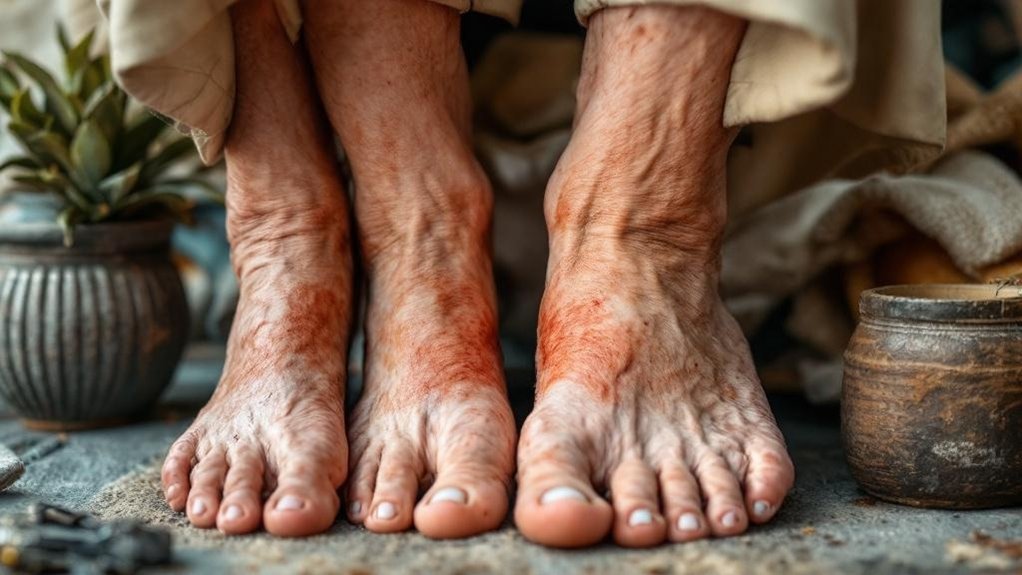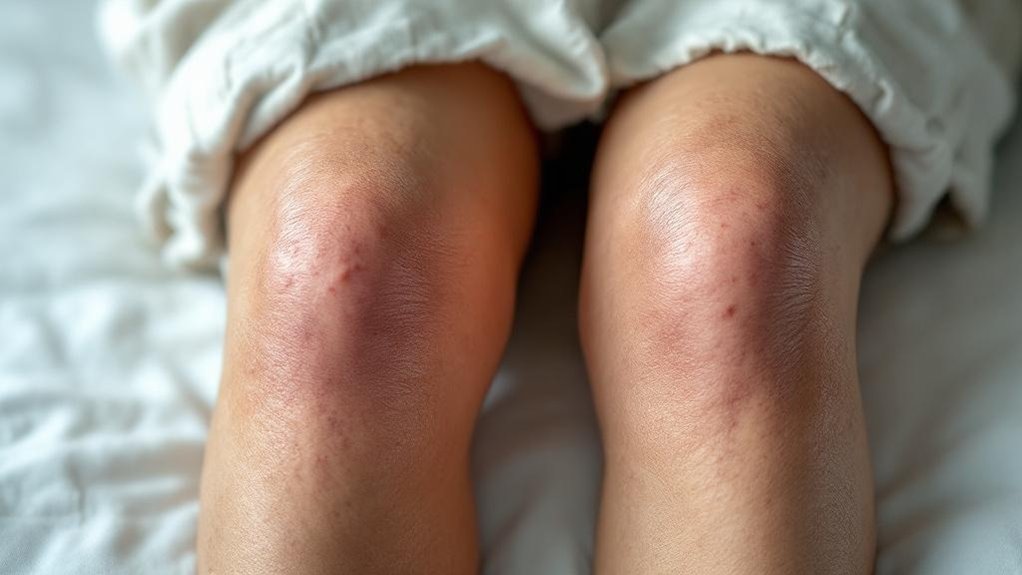Posted by: Skin And Cancer Institute in Medical Dermatology

Stasis dermatitis occurs when poor circulation causes blood to pool in leg veins, leading to skin inflammation. We’ll notice symptoms like ankle swelling, skin discoloration, and itchy patches. Treatment includes compression stockings, leg elevation, moisturizing, and sometimes prescription medications. We should avoid hot water and harsh soaps while maintaining regular exercise. Thorough management addresses both circulatory problems and skin symptoms to prevent serious complications like ulcers.
Key Takeaways
- Stasis dermatitis is a skin condition caused by poor circulation in the legs, resulting in swelling, discoloration, and itchy patches.
- Poor venous circulation causes blood pooling, increasing pressure and fluid leakage that disrupts skin health.
- Compression stockings provide graduated pressure to improve blood flow and reduce symptoms.
- Elevating legs regularly and moisturizing with fragrance-free creams helps manage symptoms at home.
- Early treatment with topical corticosteroids and consistent compression therapy prevents complications like ulceration and infection.
Identifying Symptoms of Stasis Dermatitis

How can you recognize stasis dermatitis before it becomes severe? At the Skin and Cancer Institute, we often see patients who’ve ignored early warning signs. Initial symptoms include swelling around the ankles, especially after standing for long periods, and a feeling of heaviness in the legs.
As the condition progresses, you’ll notice skin discoloration—ranging from reddish-brown to purple—and itchy, dry patches. The affected skin may become scaly, crusty, or develop open sores that heal slowly. Lifestyle modifications like regular exercise and elevating your legs can markedly reduce symptoms. Dietary considerations are equally important—reducing salt intake and maintaining proper hydration help minimize fluid retention in the legs.
We recommend consulting with our dermatology team for early intervention. Our board-certified dermatologists at Lake Havasu provide personalized treatment plans tailored to your specific skin condition needs.
Understanding the Circulatory Causes Behind Skin Changes
Stasis dermatitis develops primarily due to poor circulation in the lower extremities, where blood flow becomes compromised and creates a cascade of skin changes.
When valves in leg veins malfunction, typically due to vascular genetics or aging, blood pools instead of flowing upward to the heart. This pooling increases pressure in the veins, forcing fluid into surrounding tissues.
The resulting edema disrupts normal skin nutrition and oxygenation. Over time, inflammatory responses trigger the characteristic symptoms: redness, itching, and scaling.
In more advanced cases, circulatory anomalies lead to hemosiderin deposits that cause permanent brown discoloration.
We find that understanding these underlying mechanisms helps our patients recognize why treatment focuses on improving blood flow and reducing fluid accumulation rather than just addressing surface symptoms.
At the Skin and Cancer Institute in Gilbert, we provide early detection and comprehensive treatment options for patients experiencing symptoms of stasis dermatitis and other circulatory skin conditions.
Medical Treatment Options for Venous Insufficiency

When treating venous insufficiency, the underlying cause of stasis dermatitis, we employ several effective medical interventions to improve circulation and reduce symptoms.
Our treatment approach typically begins with compression stockings, which provide graduated pressure to help blood flow back to the heart and prevent fluid accumulation in the lower legs. For patients with more advanced venous insufficiency, we may recommend laser therapy to close damaged veins and redirect blood flow through healthier vessels. This minimally invasive procedure can notably improve circulation and reduce dermatitis symptoms.
Additional treatments in our protocol may include prescription-strength topical corticosteroids to reduce inflammation, antibiotics if infection is present, and medications that improve blood flow. We’ll work with you to develop a personalized treatment plan that addresses both your circulation issues and skin symptoms. Our expert dermatologists at the Skin and Cancer Institute prioritize patient safety and comfort throughout all treatment processes for chronic skin conditions.
Home Care Strategies for Managing Skin Inflammation
Beyond medical interventions, effective home care forms a key part of managing stasis dermatitis symptoms. We recommend elevating affected legs whenever possible to reduce swelling and inflammation. Applying cool compresses for 15-20 minutes several times daily can soothe irritated skin.
Moisturizing is essential—use fragrance-free, hypoallergenic creams immediately after bathing to lock in moisture. Avoid hot water and harsh soaps that can exacerbate symptoms. Some patients find relief through alternative therapies like compression yoga or guided meditation to improve circulation.
Similar to acne treatment, addressing stasis dermatitis may require combination therapies for optimal management of inflammation and skin healing. Nutritional supplements including horse chestnut extract, flavonoids, and omega-3 fatty acids may help reduce inflammation, though clinical evidence varies. Always consult with us before starting any supplement regimen, as these can interact with prescription medications you may be taking for venous insufficiency.
Preventing Complications and Disease Progression

Effectively preventing complications of stasis dermatitis requires a proactive, multi-faceted approach that addresses underlying venous insufficiency. We recommend regular follow-up appointments to monitor disease progression, particularly for patients with genetic factors that predispose them to venous disorders.
Lifestyle modifications form the cornerstone of prevention. We advise patients to elevate legs whenever possible, maintain a healthy weight, and engage in regular low-impact exercise like swimming or walking to improve circulation. Compression therapy should be used consistently, even when symptoms improve. Moisturizing daily with fragrance-free emollients helps maintain skin integrity and prevent cracking that could lead to ulceration.
Early intervention at the first sign of increased redness, pain, or skin breakdown can prevent the cascade toward more serious complications like chronic ulceration or infection. At Skin and Cancer Institute in Goodyear, AZ, our board-certified dermatologists provide personalized treatment plans covered by United Healthcare insurance for patients with stasis dermatitis and other skin conditions.
Frequently Asked Questions
Is Stasis Dermatitis Contagious to Family Members or Close Contacts?
No, stasis dermatitis is not contagious to family members or close contacts. There’s no skin contact risk as the condition relates to poor circulation, not infectious agents. We’re here to reassure you.
Can Stasis Dermatitis Affect Arms or Other Body Parts?
While stasis dermatitis primarily affects the lower legs, it’s uncommon in arms or other body parts. Arm symptoms are rare because they don’t typically experience the same venous insufficiency that causes this condition’s body involvement.
Does Stasis Dermatitis Increase Risk for Certain Skin Cancers?
Yes, stasis dermatitis can increase skin cancer risk. During dermatitis progression, chronic inflammation and repeated damage to skin tissue may contribute to higher susceptibility. We’ll monitor this closely during your regular skin examinations.
Will Stasis Dermatitis Completely Resolve After Treatment?
While stasis dermatitis can improve with treatment, complete resolution depends on circulation improvement. We offer medical and cosmetic treatments to address both underlying causes and cosmetic concerns associated with this condition.
Are There Specific Clothing Fabrics That Worsen Stasis Dermatitis?
Yes, tight synthetic clothing materials can worsen stasis dermatitis by restricting circulation and causing fabric irritation. We recommend loose-fitting cotton garments to reduce symptoms and improve comfort for our patients.
Conclusion
We’ve covered the essential aspects of stasis dermatitis, from recognizing symptoms to understanding its circulatory origins. With proper medical intervention and consistent home care, this condition is manageable. Remember, early treatment of venous insufficiency is vital to preventing complications. At Skin and Cancer Institute, we’re committed to providing thorough care that addresses both the visible skin manifestations and underlying circulation issues affecting your legs.